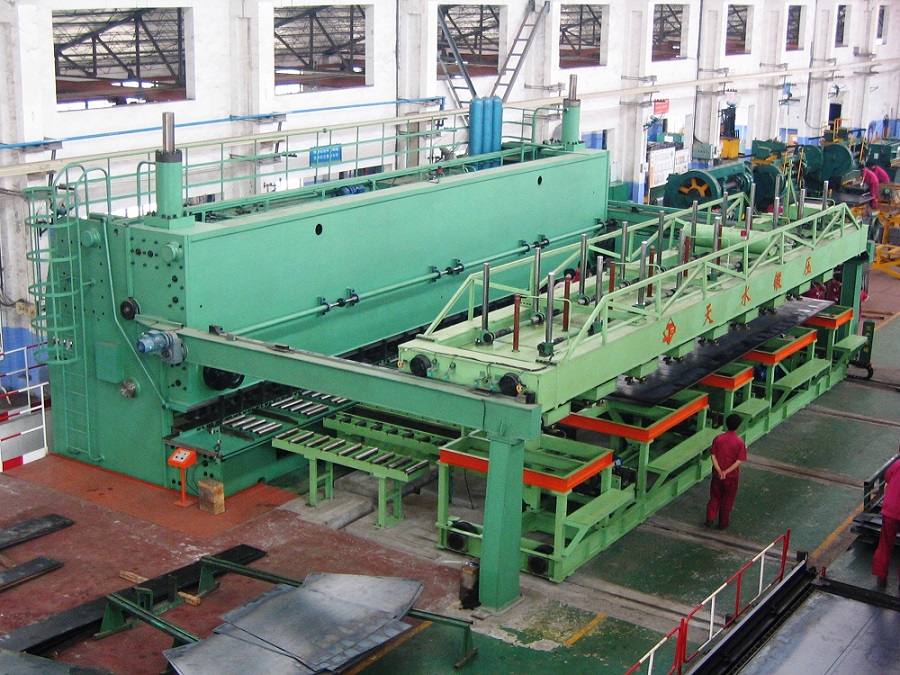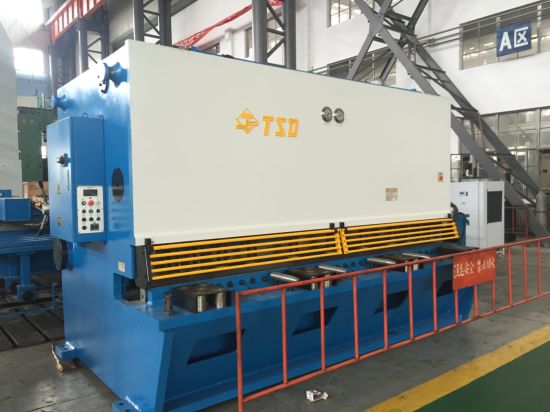Views: 0 Author: Site Editor Publish Time: 2025-10-16 Origin: Site









Ever wondered how industries achieve those precise, clean cuts in metal sheets? The secret lies in shearing machines. These powerful tools, like the Guillotine and Swing Beam Shearing Machines, are pivotal in metal fabrication. But what sets them apart? In this post, you'll learn the differences between these machines, helping you choose the right one for your needs.

A guillotine shearing machine is designed with a straightforward yet robust structure. It features a vertically moving upper blade that descends uprightly to shear materials against a fixed lower blade. This vertical motion is powered hydraulically, ensuring consistent force throughout the cutting process. The frame is typically a welded steel structure, providing excellent rigidity and stability. The clamping mechanism secures the material firmly during cutting, preventing movement and ensuring clean cuts. Additionally, the blade gap and cutting angle can be precisely adjusted, often via motorized controls, allowing the machine to accommodate various material thicknesses and types.
One of the standout specifications of the guillotine shear is its high precision. The vertical, linear movement of the upper blade guarantees a clean and accurate cut along the entire sheet length. Unlike swing beam shears, which operate with an arc motion, guillotine shears minimize distortion and burr formation due to the direct downward force. The blade design also contributes to longevity and sharpness; guillotine shears commonly use rectangular blades with four cutting edges, effectively doubling blade life compared to the diamond-shaped blades used in swing beam shears. These features make the guillotine shearing machine ideal for applications requiring tight tolerances and smooth finishes.
Guillotine shearing machines are widely used in industries where precision is critical. They excel in sheet metal fabrication shops, automotive manufacturing, aerospace components, and other sectors needing fast, accurate cuts of thin to medium-thickness metals like steel and aluminum. Their ability to adjust cutting angles and blade gaps electrically makes them versatile for various tasks, from simple straight cuts to more complex metalworking operations. While they may not match the speed of swing beam shears for high-volume production, their precision and adaptability make them a preferred choice for jobs demanding quality over quantity.
Tip: When selecting a guillotine shearing machine, prioritize models with motorized blade gap and angle adjustments to enhance cutting precision and reduce setup time.

The swing beam shearing machine features a distinct design where the upper blade moves in an arc around a fixed pivot point. Unlike the straight vertical motion of the guillotine shearing machine, the swing beam blade swings like a pendulum. This arc motion is hydraulically powered, providing consistent force throughout the cut. The frame is usually a welded steel structure, ensuring rigidity and durability during operation. The clamping system presses the material firmly against the worktable to prevent movement. However, the cutting angle on swing beam shears is fixed, which means it cannot be adjusted to optimize cutting for different material thicknesses or types. The blade on the swing beam shear typically has a diamond shape, with two cutting edges on the upper blade, which differs from the rectangular blade used on guillotine shears.
One of the swing beam shear’s main advantages is its ability to perform fast, continuous cuts. The swinging blade allows for a smooth cutting flow, making it highly efficient for high-volume production environments. Industries that require rapid processing of large sheets or plates benefit from this speed. However, this efficiency comes with a trade-off in precision. The arc motion can introduce slight deviations in the cut, which may not be suitable for applications requiring tight tolerances or extremely clean edges. Despite this, the swing beam shear remains a popular choice when throughput and speed are prioritized over absolute accuracy.
Swing beam shearing machines are widely used in heavy-duty industries such as steel fabrication, shipbuilding, and construction. They are particularly well-suited for cutting thicker metal sheets and plates, where the fixed cutting angle and robust swinging mechanism can handle demanding workloads. The machine’s ability to cut large sheets quickly makes it ideal for mass production of standardized metal components. While they may not be the first choice for precision sheet metal work, swing beam shears excel in applications where speed and durability are key.
Tip: For projects demanding high throughput and handling thicker materials, consider a swing beam shearing machine to maximize cutting speed and efficiency without compromising structural durability.
The fundamental difference between guillotine and swing beam shears lies in their cutting motion. The guillotine shearing machine operates with a vertical, straight-down blade movement. This upright motion ensures a clean, precise cut along the entire sheet length. In contrast, the swing beam shearing machine uses an arc or pendulum-like swinging motion for the upper blade. This arc motion allows continuous cutting but may introduce slight deviations in cut accuracy due to the blade’s curved path.
When it comes to material thickness, guillotine shears generally handle a wide range of thicknesses, from thin sheets to medium-thick plates. Their adjustable blade gap and cutting angle make them versatile for various metals. Swing beam shears excel with thicker materials and larger sheets. Their robust swinging mechanism and fixed cutting angle are well-suited for heavy-duty applications, such as steel fabrication and shipbuilding, where cutting speed is prioritized over intricate precision.
Guillotine shears offer significant flexibility in angle and blade gap adjustments. The cutting angle can be fine-tuned, often via hydraulic or motorized controls, to optimize cutting force and reduce sheet deformation. Blade gap adjustment is also typically motorized, allowing quick changes to accommodate different materials. On the other hand, swing beam shears have a fixed cutting angle and manual blade gap adjustment. This limits their adaptability but simplifies operation in high-volume, repetitive cutting tasks.
Maintenance requirements differ due to their mechanical designs. Guillotine shears, with their straightforward vertical blade movement and fewer moving parts, generally require less frequent maintenance. Their hydraulic systems and blade holders are designed for durability, with less wear from complex motions. Swing beam shears have a more complex mechanism involving pivot points and swinging arms. This complexity means they often need more careful maintenance and occasional adjustments to maintain cutting accuracy and machine longevity.
Tip: When deciding between guillotine vs swing beam shears, consider the importance of cutting precision and material thickness to balance maintenance needs and operational efficiency.
When deciding between a guillotine shearing machine and a swing beam shearing machine, several critical factors come into play. First, consider the nature of your projects — are you prioritizing precision or speed? Also, think about the types of materials and their thicknesses you typically work with. Guillotine shears provide excellent cutting accuracy and adaptability, making them ideal for thin to medium-thickness metals requiring clean, precise cuts. Conversely, swing beam shears excel in handling thicker materials and larger sheets, focusing on throughput and efficiency rather than ultra-fine precision.
Guillotine shear specifications highlight their strength in precision. Their vertical blade movement ensures minimal distortion and burrs, which is essential for tasks needing tight tolerances. The ability to adjust cutting angles and blade gaps further enhances their accuracy. On the other hand, swing beam shear advantages include faster, continuous cutting due to the swinging arc motion. This speed suits high-volume production where slight deviations in cut quality are acceptable. Thus, if your priority is precision over speed, a guillotine shear is the better choice. If speed and volume are paramount, swing beam shears will serve you well.
Material thickness plays a significant role in the guillotine vs swing beam shears decision. Guillotine shearing machines handle a broad range of thicknesses but are especially effective with thin to medium sheets. Their motorized adjustments allow for fine-tuning to different materials, including steel and aluminum alloys. Swing beam shears, with their robust swinging mechanism and fixed cutting angle, are better suited for thicker plates and heavy-duty materials. They are common in industries like shipbuilding and construction, where cutting thick metal quickly is essential. Understanding your material profile helps you select the machine that balances cutting quality and operational efficiency.
Tip: Evaluate your typical material thickness and production volume carefully to choose between the precision-focused guillotine shear and the high-speed swing beam shear for optimal cutting performance.
Guillotine shearing machines offer exceptional precision due to their vertical blade movement. This upright cutting action ensures clean, straight cuts with minimal distortion or burrs. The motorized blade gap and angle adjustments add to their versatility, allowing users to fine-tune the machine for various material thicknesses and types. Additionally, guillotine shears typically use rectangular blades with four cutting edges, doubling blade life compared to swing beam shears.However, guillotine shears tend to operate at a slower speed than swing beam machines, making them less ideal for high-volume production. Their complexity in blade angle adjustments and hydraulic controls may require more operator training. While maintenance is generally straightforward thanks to fewer moving parts, the precision components demand careful upkeep to maintain accuracy.
Swing beam shearing machines excel in speed and efficiency. Their swinging blade moves in an arc, allowing continuous cutting and faster throughput. This makes them perfect for industries where high-volume, rapid processing of thicker materials is essential. The fixed cutting angle simplifies operation and reduces setup time for repetitive tasks.On the downside, the arc motion can cause slight deviations in cut accuracy, which may not meet tight tolerance requirements. The diamond-shaped blades have fewer cutting edges, leading to more frequent blade changes. The complex swinging mechanism requires more frequent maintenance and skilled technicians to ensure longevity. Also, the fixed cutting angle limits flexibility for varying material types and thicknesses.
From a cost perspective, guillotine shearing machines generally have higher upfront prices due to their advanced features and precision components. However, their longer blade life and lower maintenance frequency can reduce operating costs over time. Swing beam shears usually come with a lower initial cost but may incur higher maintenance expenses due to their mechanical complexity and faster blade wear.Maintenance for guillotine shears is typically less intensive, focusing on hydraulic system checks and blade sharpening. Swing beam shears require regular inspection of pivot points, lubrication of moving parts, and more frequent blade replacements. Choosing between the two should also factor in the availability of skilled maintenance personnel and the machine’s expected workload.
Tip: Evaluate your production priorities—choose a guillotine shear for precision and lower maintenance or a swing beam shear for high-speed cutting and throughput efficiency.
Guillotine shears offer precision with adjustable blade gaps and angles, ideal for thin to medium materials. Swing beam shears excel in speed, handling thicker materials efficiently with their arc motion. Choose guillotine shears for accuracy, or swing beam shears for high-volume tasks. Tianshui Metalforming provides versatile shearing machines tailored to your needs, ensuring quality and efficiency in metal fabrication. Their products deliver exceptional value, enhancing your production capabilities with innovative technology and reliable performance.
A: The primary difference lies in their cutting motion. A Guillotine Shearing Machine uses a vertical, straight-down blade movement for precise cuts, while a Swing Beam Shearing Machine features an arc motion, allowing for faster, continuous cutting.
A: Guillotine shears are better for precision due to their vertical blade movement and adjustable cutting angles, minimizing distortion and burrs, unlike the arc motion of swing beam shears.
A: Swing Beam Shearing Machines excel in speed and efficiency, making them ideal for high-volume production of thicker materials, thanks to their swinging arc motion and robust design.
A: Guillotine shears offer adjustable blade gaps and angles for precision, while swing beam shears have a fixed cutting angle, focusing on speed with a simpler setup for repetitive tasks.
A: Guillotine shears provide high precision and long blade life but operate slower and require more complex adjustments compared to swing beam shears, which are faster but less precise.